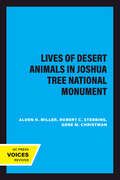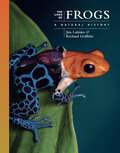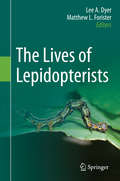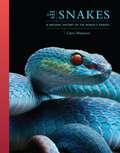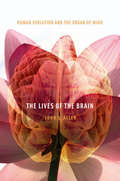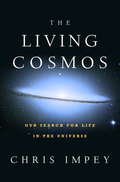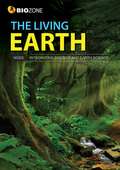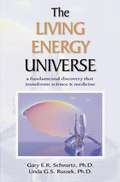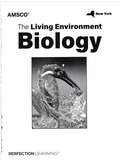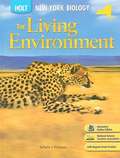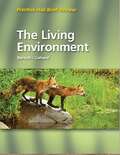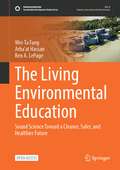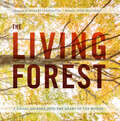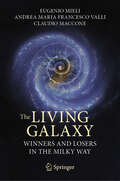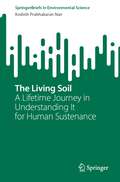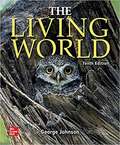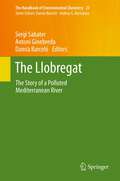- Table View
- List View
The Lives of Desert Animals in Joshua Tree National Monument
by Robert C. Stebbins Alden H. MillerThis title is part of UC Press's Voices Revived program, which commemorates University of California Press’s mission to seek out and cultivate the brightest minds and give them voice, reach, and impact. Drawing on a backlist dating to 1893, Voices Revived makes high-quality, peer-reviewed scholarship accessible once again using print-on-demand technology. This title was originally published in 1964.
The Lives of Frogs: A Natural History (The Lives of the Natural World)
by Dr. Jim Labisko Dr. Richard GriffithsA marvelously illustrated introductory guide to frogs and their natural historyFrogs are among the most diverse and adaptable animals on the planet, with a rich evolutionary history and a vitally important role in global ecosystems. With more than 7,700 species known to exist, they come in all shapes, sizes, and colors, and can be found in habitats ranging from rainforests and frozen tundras to deserts and your own backyard. This unique guide explores the physiology, behavior, ecology, and evolution of frogs, shedding invaluable light on every facet of their lives, both on land and in the water. Blending stunning photos and illustrations with engaging and informative profiles of selected species, The Lives of Frogs is an essential introduction to the natural history of these magnificent amphibians.Features a wealth of color images that bring vividly to life the remarkable world of frogsRepresentative species profiles cover key topics such as communication, reproduction, feeding habits, survival tactics, and conservationDiscusses the impact of human activity on the planet&’s frog populationsWritten by leading experts and packed with the latest scientific findingsEssential reading for nature lovers everywhere
The Lives of Lepidopterists
by Lee A. Dyer Matthew L. ForisterInchworms, tiger moths, underwings, owlet moths, silkworms,sphinx moths, grass moths, and butterflies. Collectively, these and many others are the Lepidoptera, one of the most diverse groups of animals on the planet. Lepidoptera can be found in the highest tropical canopies,the driest deserts, and at the leading edge of science. The adults include some of the most beautiful insects that have inspired artists and have sailed through the dreams of human cultures for millennia. The immature stages ("caterpillars"), like the underwing depicted on the cover, link together vital processes in diverse terrestrial ecosystems that are only barely documented let alone understood. The people that study these animals are lepidopterists, and the goal of this book is to introduce them with their own words. In twenty chapters, lepidopterists tell their stories, and these tales mirror the diversity of nature in their range and depth. You will find individuals that wrestle with the challenges of scientific careers, stories of far flung travel sand close calls, and historical perspectives on recent decades of scientific break throughs.
The Lives of Snakes: A Natural History of the World's Snakes (The Lives of the Natural World)
by Chris MattisonA richly illustrated introduction to the marvelous world of snakesDescended from prehistoric lizards, snakes have been slithering across the earth for more than a hundred million years. There are some 4,100 species known to exist, and many are venomous, but many more are not. Snakes experience the world in unique ways, smelling the air with their tongues and relying on signs of movement for orientation. They are ectothermic, needing external heat for energy, and must shed their skin to grow. This guide offers a unique look at the lives of snakes, exploring their life cycles, diets, defenses, locomotive strategies, and more. Written by an internationally recognized herpetologist and informed by the latest science, The Lives of Snakes blends captivating photos with engaging, fact-filled profiles of selected species to provide an invaluable introduction to these splendid reptiles.Combines beautiful illustrations, clear graphics, and lively text to inform and entertainFeatures dozens of representative species profilesCovers topics ranging from evolution and diversity to habitats and reproductionExamines how snakes coexist with humansDiscusses threats to the world&’s snake populations and their conservationA must for snake lovers everywhere
The Lives of the Brain: Human Evolution And The Organ Of Mind
by John S. AllenThough we have other distinguishing characteristics (walking on two legs, for instance, and relative hairlessness), the brain and the behavior it produces are what truly set us apart from the other apes and primates. And how this three-pound organ composed of water, fat, and protein turned a mammal species into the dominant animal on earth today is the story John S. Allen seeks to tell.
The Living Cosmos: Our Search for Life in the Universe
by Chris ImpeyAstrobiology, the study of life in space, is one of today's fastest growing and most popular fields of science. In this compelling, accessible, and elegantly reasoned new book, award-winning scholar and researcher Chris Impey explores the foundations of this rapidly developing discipline, where it's going, and what it's likely to find. The journey begins with the earliest steps of science, gaining traction through the revelations of the Renaissance, including Copernicus's revolutionary declaration that the Earth was not the center of the universe but simply a planet circling the sun. But if Earth is not the only planet, it is so far the only living one that we know of. In fascinating detail, The Living Cosmos reveals the incredible proliferation and variety of life on Earth, paying special tribute to some of its hardiest life forms, extremophiles, a dizzying array of microscopic organisms compared, in Impey's wise and humorous prose, to superheroes that can survive extreme heat and cold, live deep within rocks, or thrive in pure acid. From there, Impey launches into space, where astrobiologists investigate the potential for life beyond our own world. Is it to be found on Mars, the "death planet" that has foiled most planetary missions, and which was wet and temperate billions of years ago? Or on Venus, Earth's "evil twin," where it rains sulfuric acid and whose heat could melt lead? ("Whoever named it after the goddess of love had a sorry history of relationships.") The answer may lie in a moon within our Solar System, or it may be found in one of the hundreds of extra-solar planets that have already been located. The Living Cosmos sees beyond these explorations, and imagines space vehicles that eschew fuel for solar- or even nuclear-powered rockets, all sent by countries motivated by the millions to be made in space tourism. But The Living Cosmos is more than just a riveting work about experiment and discovery. It is also an affecting portrait of the individuals who have devoted their lives to astrobiology. Illustrated throughout, The Living Cosmos is a revelatory book about a science that is changing our view of the universe, a mesmerizing guide to what life actually means and where it may--or may not--exist, and a stunning work that explains our past as it predicts our future.
The Living Earth (HMH Science: California Dimensions)
by Stephen NowickiThe Living Earth: Integrating Biology and Earth Science answers. Shed the societal and cultural narratives holding you back and let free step-by-step The Living Earth: Integrating Biology and Earth Science textbook solutions reorient your old paradigms.
The Living Earth: Student Edition
by Tracey GreenwoodBIOZONE's new integrated titles for the Next Generation Science Standards for California Public Schools (CA NGSS) have been designed and written following the High School Three- Course Model. Each of these phenomena-based titles integrates a three-dimensional approach to provide an engaging, relevant, and rigorous program of instruction. Departing from the more traditional approach of BIOZONE's Non-Integrated Series, the Integrated Series offers a learning experience anchored in student-relevant phenomena and problems.
The Living Energy Universe: A Fundament Discovery Transforms Science and Medicine
by Gary E. Schwartz Linda G. S. RussekThis book presents the idea that everything, at every level of existence, is alive, remembers, and evolves. Schwartz and Russek's systemic memory hypothesis is proposed to explain not only many puzzles in conventional science, but also major mysteries such as reflective self-awareness, homeopathy, survival after death, and psychic abilities. These authors gives serious consideration of these latter topics with a enthusiastic writing style.
The Living Environment (NY Edition)
by Mcdougal LittelThis book covers Biology New York educational standards for grades 8 through 12.
The Living Environment 2013 (Prentice Hall Brief Review For The New York Regents Exam)
by John Bartsch Mary P. ColvardThis book is designed to enhance review of the concepts, skills, and applications of The Living Environment Core Curriculum that may be tested on the Living Environment Regents Examination. For nearly all students, passing this examination will be a requirement for graduation from high school.
The Living Environment Biology
by AmscoDesigned specifically for the New York Regents exam, Reviewing the Living Environment provides systematic coverage of tested content, review questions for each standard, and extensive Regents exam practice. Features include abundant illustrations to enhance comprehension, content vocabulary defined in context, a glossary of terms, and much more. Recent Regents exams included in each student edition help ensure students' readiness for the test.
The Living Environment: Holt Biology (New York Edition)
by Michael R. Heithaus Rob DesalleBiology, the study of life, directly applies to your health, life, and future in ways as simple as making daily food choices or as complex as deciding which career to pursue.
The Living Environment: Prentice Hall Brief Review for the New York Regents Exam
by John Bartsch Mary P. ColvardThe Living Environment: Prentice Hall Brief Review for the New York Regents Exam
The Living Environmental Education: Sound Science Toward a Cleaner, Safer, and Healthier Future (Sustainable Development Goals Series)
by Wei-Ta Fang Ben A. LePage Arba'at HassanThis open access book is designed and written to bridge the gap on the critical issues identified in environmental education programs in Asian countries. The world and its environments are changing rapidly, and the public may have difficulty keeping up and understanding how these changes will affect our way of life. The authors discuss various topics and case studies from an Asian perspective, but the content, messaging, and lessons learned need not be limited to Asian cultures. Each chapter provides a summary of the intensive research that has been performed on pro-environmental behaviors, the experience of people working in industry and at home, and their philosophies that guide them in their daily lives. We highlight humanity’s potential to contribute to Sustainable Development Goals (SDGs) by understanding better the environmental psychology, social inclusion, and environmental sustainability and stewardship protection elements that contribute to responsible environmental citizenship. The content of the chapters in this book includes a discussion of the crucial issues, plans, and evaluations for sustainability theories, practices, and actions with a proposed management structure for maximizing the cultural, social, and ecological diversity of Asian experiences compared to other theories and cultures internationally. We intend that the data in this book will provide a comprehensive guide for students, professors, practitioners, and entrepreneurs of environmental education and its related disciplines using case studies that demonstrate the relationship between the social and behavioral sciences and environmental leadership and sustainability.
The Living Forest: A Visual Journey Into the Heart of the Woods
by Robert Llewellyn Joan Maloof“With precise, stunning photographs and a distinctly literary narrative that tells the story of the forest ecosystem along the way, The Living Forest is an invitation to join in the eloquence of seeing.” —Sierra Magazine From the leaves and branches of the canopy to the roots and soil of the understory, the forest is a complex, interconnected ecosystem filled with plants, birds, mammals, insects, and fungi. Some of it is easily discovered, but many parts remain difficult or impossible for the human eye to see. Until now. The Living Forest is a visual journey that immerses you deep into the woods. The wide-ranging photography by Robert Llewellyn celebrates the small and the large, the living and the dead, and the seen and the unseen. You’ll discover close-up images of owls, hawks, and turtles; aerial photographs that show herons in flight; and time-lapse imagery that reveals the slow change of leaves. In an ideal blend of art and scholarship, the 300 awe-inspiring photographs are supported by lyrical essays from Joan Maloof detailing the science behind the wonder.
The Living Galaxy: Winners and Losers in the Milky Way
by Claudio Maccone Eugenio Mieli Andrea Maria ValliThis book describes the possible distribution of life in the Milky Way. Our description is mathematical in order to be extrapolated from what we know that happened on Earth to what might have happened on the huge number of extrasolar planets existing in the Milky Way Galaxy. We use the statistical Drake equation, which identifies parameters for calculating the total number of life forms at all levels. While the original Drake equation (1961) contained seven factors only, we extend the number of factors to 50, thus incorporating much of the scientific knowledge about the Evolution of Life available in 2024. As such, this book aims at being a narrative of a series of events, starting with pre-life epochs and extending them into the present and into the future. This book, while well rooted in scientific and mathematical models, depicts the drama of life - whether it emerges and thrives or succumbs and vanishes. It's a tale of attempts, defeats, and progress, unfolding not along the scale of Human Lifetimes, but rather along the scale of Galactic Civilizations billion years long.
The Living Soil: A Lifetime Journey in Understanding It for Human Sustenance (SpringerBriefs in Environmental Science)
by Kodoth Prabhakaran NairThis book will address the importance of the soil management concept, vis-à-vis chemical fertilizer use on soil. Historically, soil testing has been used to quantify bio availability of plant nutrients to field grown crops. However, contemporary soil tests are based on philosophies and procedures developed several decades ago without significant changes in their general approach. For a soil test to be accurate, one needs to clearly understand the physico-chemico-physiologic processes at the soil-plant root interface, and, an understanding of soils and plant root systems as polycationic systems is essential. It is this knowledge that leads to sound prescriptive soil management practices inasmuch as nutrient bioavailability vis-à-vis chemical fertilizers application is concerned, because, of all the factors that govern sustainability of crop production, the nutrient factor is the most important, yet, it is also the least resilient to effective management. The author’s research spanning over three decades in Europe, Africa and Asia, establishes the fact that precise quantification of the nutrient’s “buffer power” holds the key to a clear understanding of the plant bioavailability of some of the most important plant nutrients in crop production, such as, phosphorus, potassium and zinc. “The Nutrient Buffer Power Concept” attempts to clearly explain the bio availability of the three plant nutrients named above on the basis of the diffusion model, as that is the process by which these three important principal plant nutrients are absorbed from the soil by the plant root. Possibly, other plant nutrients which are taken up by the plant roots by the same diffusive model, would also conform to the principles of the concept. A thorough knowledge of thermodynamic principles on the part of the researcher is an absolute pre requisite for this. The book chronicles more than three decades of the professional journey of the author in Europe, Africa and Asia, understanding soil for human sustenance, and developing the revolutionary soil management concept, now globally known as, "The Nutrient Buffer Power Concept" , which has brought the author a string of international recognitions, including the nomination for the "Alternative Nobel Prize" (The Right Livelihood Award),of Sweden, and succour to millions to poor and marginal farmers across Africa, Asia and Latin America.
The Living Wilderness
by Rutherford MontgomeryRutherford G. Montgomery, one of the most widely-read and best-loved nature-writers in the country, has written well over a hundred books of fiction, most of them involving his favorite "friends of the wilderness." The Living Wilderness is a distillation of his personal experiences with wild-life, a recapitulation of the breadth and depth of his observation and knowledge of the wild creatures which we seldom see--unless we look for them.
The Living World
by George B. JohnsonThe Living World is often considered a student favorite. George Johnson has written this introductory biology textbook from the ground up to be an engaging and accessible learning tool with an emphasis on "how things work and why things happen the way they do". The Living World focuses on concepts rather than terminology and technical information, and features a straight forward,clear writing style and a wide variety of media assets to enhance the content of the textbook. George believes that ‘relevancy is the window’ in which students can learn biology. This is shown through every chapter of this 10th edition, which is focused directly on the relevance of its content to today’s students. When the discussion of a topic is linked to a student’s own experience, it does not seem so unapproachable, and the utility of learning it is far easier to accept.
The Living World (5th Edition)
by George B. Johnson Jonathan B. LososCutting edge biological concepts delivered with a greater emphasis on evolution and a logical use of analogies. George Johnson's textbook, "The Living World" is often considered to be a student favorite. Dr. Johnson has written this non-majors textbook from the ground up to be an engaging and accessible learning tool with an emphasis on "how things work and why things happen the way they do," This authoritative textbook features a straightforward, clear writing style and a wide variety of media assets to enhance the content of the textbook.
The Lizard Scientists: Studying Evolution in Action (Scientists in the Field)
by Dorothy Hinshaw PatentIn this groundbreaking, exceptionally researched installment of the award-winning Scientists in the Field series, discover how lizards rapidly adapt to life in the Caribbean islands, allowing scientists to study Charles Darwin’s theory of evolution by natural selection in real time. Award-winning author Dorothy Hinshaw Patent joins forces with scientists/filmmakers Neil Losin and Nate Dappen, whose work is detailed in the Smithsonian Channel documentary “Laws of the Lizard,” to explore how the small but mighty lizards we call “anoles” are used by scientists to study basic principles of evolution and ecology. Travel with the team to Florida and the Caribbean as they research how anoles followed similar but independent evolutionary paths on the four major islands of the Greater Antilles (Puerto Rico, Hispaniola, Jamaica, and Cuba). So while anoles on different islands may look like close relatives, they often are not! This is Darwin's principle of natural selection at work.And it makes anoles the perfect subjects for experiments that study how animals adapt to new challenges—such as climate change—in this exciting and timely addition to a celebrated series.
The Llobregat
by Sergi Sabater Damià Barceló Antoni GinebredaThe Llobregat belongs to the most thoroughly studied rivers in Europe and is a paradigm of the confluence of human and natural disturbances in a single basin. Because of its location in a very densely populated region and its Mediterranean character, the Llobregat supports a mixture of irregular flow, water abstraction, excess nutrients, mining debris, and a wide array of pollutants. The aquatic organisms strive to survive in a dramatically changing river that passes through a succession of dams, weirs and channels. The long-term river monitoring as well as the research that has been carried out in the river for a long time have provided an extensive knowledge of these disturbances and their effects on the biological communities. This book highlights the available information, with emphasis on the hydrological, chemical and biological elements interspersed in the river. Experts in the field discuss the main nutrient patterns and pollutant occurrence and the responses of the biological quality elements as well as the river ecosystem to the overall natural and man-made influences.
